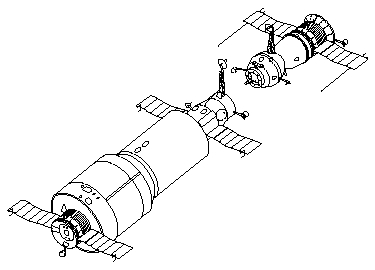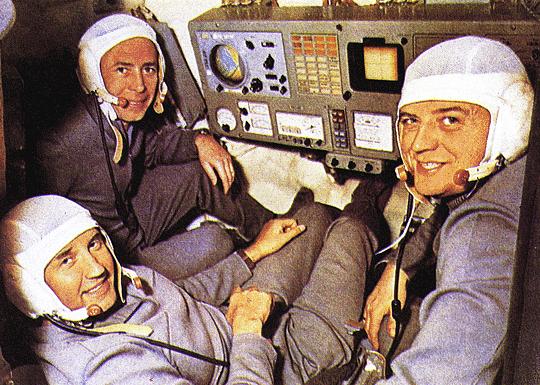Salyut 1: The First Space Station

This is part of a Space.com series of articles on the Greatest Moments in Flight, the breakthrough events that paved the way for human spaceflight and its next steps: asteroid mining and bases on the moon and Mars.
Despite an array of problems, the first space station, Salyut 1, made important progress toward living and working in space long-term and paved the way for future space stations. Launched by the Soviet Union in 1971, the port orbited the Earth almost 3,000 times during its 175 days in space before it was intentionally crashed into the Pacific Ocean.
Shaped like a cylinder, Salyut 1 bore three pressurized compartments for astronauts and one unpressurized area containing the engines and control equipment. The station was about 65 feet (20 meters) long and 13 feet (4 meters) in diameter at its widest point. Two double sets of solar panels extended like wings on the exterior of the compartments at either end.
Visiting the space station
Salyut 1 launched unmanned from the Soviet Union on April 19, 1971. Two days later, Soyuz 10 lifted off, carrying a crew of three toward the space station with the intention of remaining in space for 30 days. The cosmonauts attempted to dock with Salyut 1, but although they were able to lock onto the station, a problem with the hatch kept them from being able to enter it. They returned home early and unsuccessful. During the re-entry process, a problem rendered the air supply of Soyuz 10 toxic, and one of the cosmonauts slipped into unconsciousness. All three survived with no long-term effects.
On June 6, Soyuz 11 transported cosmonauts Georgi Dobrovolski, Vladislav Vokov, and Viktor Patsayev to Salyut 1, where after three hours, they successfully docked with the station. They remained on board for 383 orbits in the course of just over three weeks, setting a new space endurance record. On June 16, smoke from a control panel caused the crew to consider abandoning the station, but the unit was switched off and the problem averted.

On June 29, the crew transferred back to the Soyuz 11 and began the return to Earth. Disaster struck when a ventilation valve was jolted open during the re-entry, depressurizing the interior of the ship. Cosmonauts at the time did not wear suits while in flight, so all three men were tragically killed. As a result, several changes were made to the Soviet policy, but they could not be implemented while Salyut 1 remained in orbit. No further trips were made to the station.
On October 11, 1971, the engines on Salyut 1 fired for the last time, bringing the space station into a lower orbit that would result in its eventual plunge into the Pacific Ocean. But despite its early death, Salyut 1 set the stage for stations to come after. The Soviets continued to put short-term stations into space for several years until they felt they were ready for a long-term project.
Mir and the ISS
In 1986, the Soviet Union launched the first components of the space station Mir, which was assembled in orbit over the course of a decade. Considerably larger than Salyut 1, Mir was just over 60 feet (19 meters) long and 100 feet (31 meters) wide. It weighed in at 285,940 pounds (129,700 kilograms), more than seven times more massive than the world's first space station.
Mir orbited the Earth more than 86,000 times over the course of fifteen years, and was occupied more than 80 percent of its time in space. The space station had the capacity to support a crew of three, with occasional short-term visitors. Valeri Polyakov spent 437 days 18 hours aboard Mir, setting the record for the longest single human space flight. Mir returned to Earth on March 23, 2001, crashing into the South Pacific Ocean.
Pieces of the ninth inhabited space port, the International Space Station, or ISS, were first launched in 1998. A joint project between five space agencies — the United States, Japan, Canada, Russia, and the European Space Agency — the port has been visited by astronauts from more than 15 countries. At almost 240 feet (72.8 meters) long and 356 feet (108.5 meters) wide, the ISS weighs just under twice the mass of Mir. In 2010, it broke Mir's record of days in flight, and remains there today, serving as a laboratory and observatory in space. [Infographic: The International Space Station Inside and Out]
Although the first space station in flight, Salyut 1, was marred by problems, it set the stage for larger and more permanent residencies that would provide greater opportunities to endure the rigors and challenges of life off-planet.
—Nola Taylor Redd
Related:
The Greatest Moments in Flight
- The First Hot-Air Balloon
- The First Powered Airship
- The Wright Brothers & the First Flight
- World's First Commercial Airline
- Charles Lindbergh & the First Solo Transatlantic Flight
- Breaking the Sound Barrier
- The First Man in Space
- Apollo 11: First Men on the Moon
The Most Amazing Flying Machines Ever
- The First Airplane: Wright Flyer
- The Red Baron & Aerial Weapons of World War I
- The Zeppelin Hindenburg: When Airships Ruled
- The First Fighter Jet: Me 262 Schwalbe
- SR-71 Blackbird: Supersonic Spy Aircraft
- Saturn V Rocket & Apollo Spacecraft
- Space Shuttle: The First Reusable Spacecraft
- International Space Station
- SpaceShipOne: The First Private Spacecraft
Image galleries:
Join our Space Forums to keep talking space on the latest missions, night sky and more! And if you have a news tip, correction or comment, let us know at: community@space.com.
Get the Space.com Newsletter
Breaking space news, the latest updates on rocket launches, skywatching events and more!

Nola Taylor Tillman is a contributing writer for Space.com. She loves all things space and astronomy-related, and enjoys the opportunity to learn more. She has a Bachelor’s degree in English and Astrophysics from Agnes Scott college and served as an intern at Sky & Telescope magazine. In her free time, she homeschools her four children. Follow her on Twitter at @NolaTRedd










